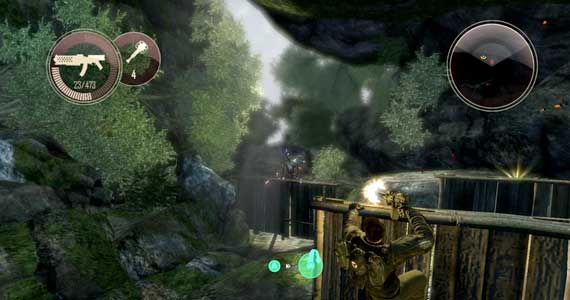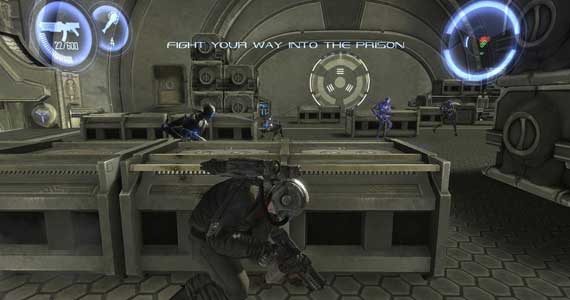
My enthusiasm for Dark Void during the long march toward a retail release owes entirely to a conceptual proposition that represents everything I wanted from a game when I was ten. Admittedly I had no idea at that time that trying to merge two distinctly different styles of play inherently invites disaster – or at least it seems that way given how much trouble many designers have delivering on a single style successfully.
My thought at the time would have been that flying and shooting robots is cool, and running and shooting robots is cool, so that merging the two into a single title should reasonably create the greatest game of all time.
Maybe I wasn’t the brightest kid on the block, but let’s move on.

For the kid in me, Dark Void is a heart breaker, but not because that merger failed. In fact, thinking back on releases over the last few years, many of which have been praised despite glaring glitches that make them at times unplayable, the most shocking turn of events isn’t that the review rush for the cleverest pun views Dark Void as a pinata for stress relief, but that the game works nearly so well as it does.
That doesn’t lay a foundation for saying that Dark Void is a great game, or even one of the good-bad games I love so dearly. But it isn’t occasional screen tears, robots popping in and out of positions, or death by jetpack accidents that disappoint me. The heartbreak is that there’s at least 45 minutes within the game where a clearly better experience could have emerged during a generous stretch of time to develop just that.
I’d almost say that I can’t recall the last time a game instantly invited such loathing from the more verbal factions of the internet gaming republic – or that I’ve never spent so much time arguing with other editors about issues within a game, but that’s not entirely true because I’m reminded quite a bit of the reaction to 2009’s Velvet Assassin.

Once again, this isn’t some roundabout path toward pronouncing Dark Void a good gaming investment, I’m simply baffled at the poisonous reaction that can drive reviews for a title so low while others are allowed to float so high. As a result, I’ve spent what I’d consider an excessive amount of time flying the friendly skies of Dark Void in an attempt to ascertain what exactly is wrong with the controls. Sadly you’ll have to hit up Metacritic for the skinny, because for the life of me I can’t find where that portion of the game so drastically misses the physical mark.
The flying bits of Dark Void feel quite a bit like what I imagine Crimson Skies 2.0 would feel like – imagine that. Touring around the skies with the jetpack, the player is free to spray ammo from mounted machine guns, enter anti-aircraft artillery and allied planes, execute special maneuvers that turn the player on a dime when being hunted, and land on enemy ships with the press of a button in order to hijack them with some further button prompting. In the entirety of that scenario it was only the button prompts that left something to be desired, though they are most often used by rapidly tapping the button to grip as the ship attempts to shake the player loose.
For all the times I died during flight sequences, I hit a cliff twice, the rest of my fatalities caused by enemy gun fire or failing the objective – I really loathe protection objectives but I can’t blame that on the controls.

There’s plenty of room to see the jousting vibe that can emerge during aerial combat, but the emphasis on defense simply makes the game easier to manage by hunkering inside an anti-aircraft gun to lay down more suppressing fire and fulfill the babysitting duties the game continually burdens players with.
Even though Dark Void makes poor use of this aerial playground, there’s enough in the idea to furnish a reasonably good flight based action game. But Dark Void doubles the bet by adding ground based combat, which doesn’t come across as particularly unsound. The aerial portion is solid enough that even a broken attempt at ground combat shouldn’t derail the game entirely. And while it doesn’t, it does an awful lot to confuse the focus and fracture any sense of balance.
Simply put, the player is not given enough choice between the two approaches – offered levels rather than even the smallest sandbox opportunities so that stages feel like either ground-based or aerial-based instances rather than blurring the line with the harmony I’d anticipated.
Ground combat fed my straight-forward expectations, providing nothing particularly fantastic but also nothing that fell sharply beneath other titles. The game has heavy footsteps, not unlike a title such as Red Faction Guerrilla, most notably because there’s a sluggish sense of control that makes one feel like a brick when jumping and running – along with an inability to grab ledges.
To keep with the heavy hitting, players can melee attack with a button prompt to bash robots in the face, and the game has a semi-competent cover system familiar to many – run toward crates, hide behind crates, shoot, advance, repeat.

Vertical combat was the potential hero here for staving off monotony, allowing players to change their perspective by using the jetpack to grip ledges and platforms at angles gravity wouldn’t normally allow for. Essentially it changes the way players climb or descend by turning into an arcade-esk shooting experience where you leap from platform to platform while blasting robots that can do the same – they often won’t bother because robots lack a strong instinct for self-preservation, perhaps best illustrated by the suicide model.
When you bring these aspects together I’m still convinced there’s space enough for a good experience, and that I very nearly found a trace of it.
On a prison raid mission, I flew in with the troops and took out the outer defenses, flying into the base to engage more troops on the ground. The jetpack allowed me to take higher ground and manipulate the situation, and I got a real taste of what vertical combat had to offer even if it feels tacked on. There was the briefest moment where the experience gelled to deliver a sense of guerrilla combat with options open to just how the player wants to tackle the challenges. Dark Void really wants to say you can have it your way, not unlike a flame broiled whopper.

The problem is that this is the closest instance of cohesive excitement the game has to offer. The majority of the relatively short experience continually feels like a training seminar. The initial trek on foot through the jungle, collecting plane parts before getting the jetpack, escorting AI comrades determined to die, and guarding that accursed Ark all feel like training wheels meant to be building toward the point when the game opens up and gives the player space to find their own game in the merger of styles available.
It’s aggravating, but I legitimately felt like it was moving toward a more open experience until the oddest thing happened – the game bloody well ended. Dark Void literally takes its ball and goes home. In fact what it actually does is introduce you to a cleric type character who is going to reveal how important you are and give rise to a massive campaign, which is instead reduced to being shown where a portal is, fighting a boss, and watching the clumsy conclusion.
This is the part of the game I can’t comprehend beyond assuming there’s some entirely different chunk of game that was deemed unsuitable, causing this version to be sewn together to simply get the game out the door.
Burden of proof? The game introduces a shape-shifting character who takes on the form of the person it kills – and then it leaves. In any other instance the entire point of that scenario would be in the creature assuming the dead person’s place right? Why else would it take their form?

Dark Void goes to a decent amount of trouble to demonstrate different enemy units, tediously drag the player through the do’s and do-not-do’s of jetpacking and ground combat, and then bypasses the story points of an already weak story as if it got bored of its own linear direction. In short, the game invites you inside, unzips your pants and breathes heavily into your ear only to tell you it has a headache and show you out.
I just can’t figure it out, because any other studio would have at least limped to the finish line by making the player jump through the same levels again with different enemy patterns.
It’s frustrating as hell, because if you’d asked me how it was going after my first few hours with the game, I would have earnestly said that it was promising. For everything that’s going on in the game, the fact that I could do it all well enough 90% of the time did legitimately impress the hell out of me.

When I think of what could have been in Dark Void, I’ll forever remember a battleship that required you to shoot outer defenses in order to land on the deck to disable the core.
When I think of what actually was, I’ll remember the sudden Half-Life 2 scenario that takes away the toys at what should represent the turning-point toward a better game.
The problem is less about the prescription and more about the dosage, which leaves me hazy and wondering where the rest of this game went, because the absence is clearly creating the most space for the obligatory jokes about the void at work within this release.
Dark Void
Developer – Airtight Games
Publisher – Capcom
System – PC, PlayStation 3, XBOX 360 (PS3 Reviewed)
Release Date – January 19, 2010
*A copy of this title was provided by the publisher for review
This is a game that I would have eventually bought anyhow. I will however wait on it like I did with Bionic Commando (the new one… with the dumb dreadlocks…) until it hits $20. Sorry Capcom. I love you. I truly do. I will buy Dead Rising 2 and Lost Planet 2 when they come out… at full price… (or as close enough… with Amazon’s usual $5 discounted prices…) but this one will have to wait. I still haven’t even opened my $20 Bionic Commando game…
Comment by Ujn Hunter — January 20, 2010 @ 11:49 am
Well, well… I actually just bit on this game this week. It’s in the mail as we speak, it dropped to $22.xx and that was good enough. However reading my previous comment, I’m sad to say that I had canceled my Lost Planet 2 pre-order and will wait until that game is $30. Every review I had read kept saying that it was designed to be a Co-op game and it wasn’t good (or unnecessarily difficult) solo.
Comment by Ujn Hunter — May 17, 2010 @ 9:52 am